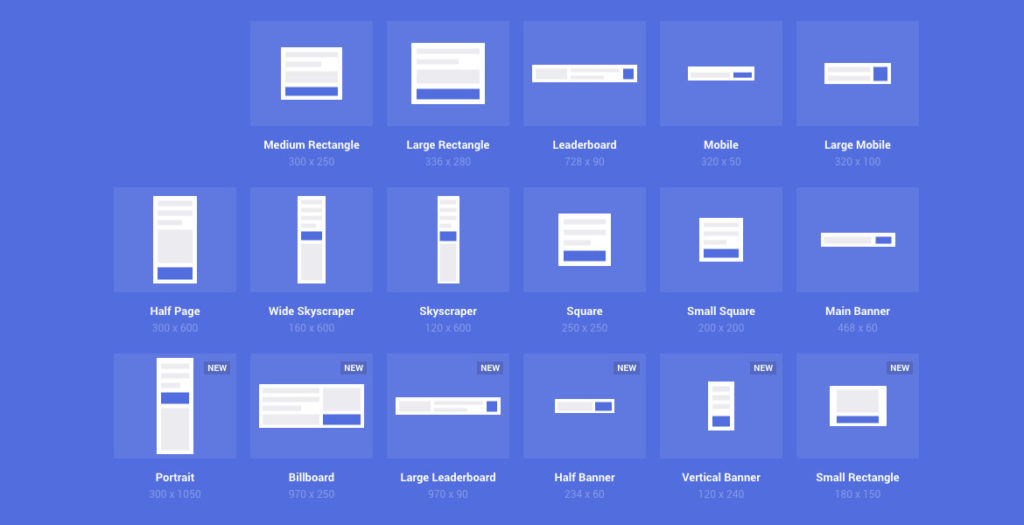What are Standard Ad Sizes in Display Advertising?
What are ad sizes and why is it important to know about the about standard ad sizes when advertiser is planning to run an ad campaign in display advertising.
Ad Size is a common dimension to place a marketing message on a web pages. The ad sizes have defined by Interactive Advertising Bureau (IAB) to minimize the ad serving issues when the publishers and advertisers are connected through a common platform.

The Ad Sizes will differ on Desktop and Mobile devices based on the screen size that users are using. The ad servers will scale the ad size according to the users’ screen to enhance the readability and experience. However, experience is usually based on the number of ads placed and how it is displaying on a web page.
Here are most common standard ad sizes:
- Square – 250 x 250
- Small Square – 200 x 200
- Banner – 468 x 60
- Leaderboard – 728 x 90
- Inline Rectangle – 300 x 250
- Large Rectangle – 336 x 280
- Skyscraper – 120 x 600
- Wide Skyscraper – 160 x 600
- Half-Page Ad – 300 x 600
- Large Leaderboard – 970 x 90
All the ad sizes may not attract the potential customer’s attention while browsing the web pages. Due to this reason, advertisers preferably choose the following the ad sizes to promote their products effectively. Also, the following ad size are highly interactive and effective based on the studies conducted.
- 300×250 – Medium rectangle
- 336×280 – Large rectangle
- 728×90 – Leaderboard
- 300×600 – Half page or large skyscraper
- 320×50 – Mobile leaderboard
Here’s an article to read Top 7 Advantages of Display Advertising
Let’s understand the top performing ad size in detail below:
Medium Rectangle (300×250)
This is one of the most popular ad sizes that we always see on the web pages. This ad size most compatible to serve ads on most of all the devices and screen sizes. These ads usually place on the top sidebars, between the articles and end of the article to gain user’s attention. Another major advantage of this ad size is that it will not distract the user attention while going through web page content.
Large rectangle (336×280)
This is another popular ad size that publishers prefer to use between the content to attract the user’s attention and convert the potential user in to sales. However, this ad size may not get many impressions compared to Medium Rectangle, but it is still popular ad size for advertiser to creatively design their marketing message with larger space.
Leaderboard (728×90)
The leaderboard ad usually places on the top of the web page where users can see the ad before the content. The advertiser usually chooses this ad size as it will be placed on the noticeable place of each and every web pages along with the bottom of the web page. This ad size generates the higher user engagement compared to other ad sizes.
Half page or large skyscraper (300×600)
As name says, this is one of biggest vertical ad size that cover half a page of the website. These types of ads will be placed on sidebars to avoid interrupting the users while going through the web pages. This ad size comes with huge space to convey the marketing message. However, this ad size requires stunning visuals to attract the users and prompting them to click on the ad.
Mobile leaderboard (320×50)
Mobile leaderboards is one of the most popular optimized ad size to run on mobile devices. This has a limited space place the marketing message but it generates the maximum interactions on the mobile devices. The advertisers use the short text messages to design these types of ads instead of using the creatives.
Conclusion: These top performing ad sizes helps the advertisers to boost their products and services quickly. However, advertisers consider the other ad sizes to drive their potential customer to their landing pages to convert a sale.
We would suggest the advertisers to get started with the top performing ad sizes and conduct the A/B testing to understand which is ad size is performing better for the audience that you are targeting.
Let us know down in the comments in case of any questions. We are happy to answer them!




